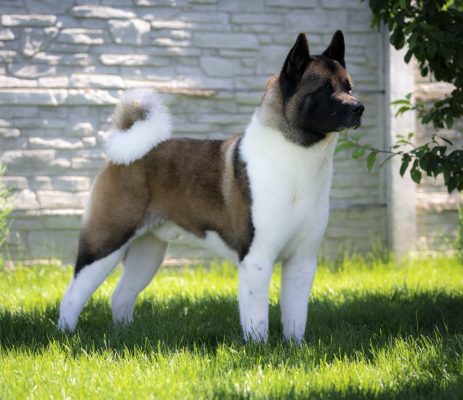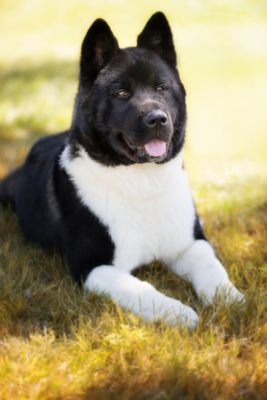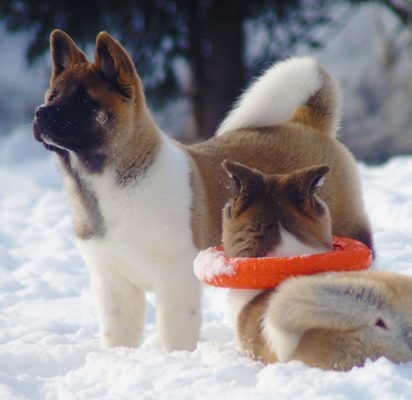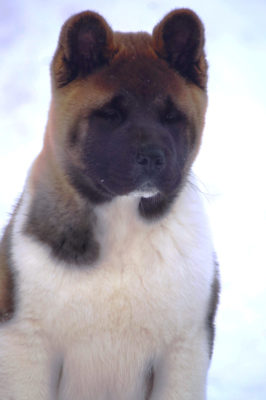American Akita

The blood that is inherited from the mastiff makes itself felt at all times. The American Akita may look cute and friendly, but it is always proud and wary. Training from an early age is a must because it can become uncontrollable and dangerous to strangers without authority represented by the owner. Does not tolerate loneliness and prolonged separation from the owner.
Table of Contents
Breed Information
| Another Name | Great Japanese Dog |
| Origin | Japan |
| Height | Males 66-71 cm Females 61-66 cm |
| Weight | 32-59 kg |
| Fur | Medium |
| Color | Red, pale, white, pale-white, tiger, spotted (pinto) |
| Lifespan | 10-14 years |
| FCI Classification | Spitz and primitive types |
| Group | Dogs for children, guard dogs, sled dogs, hunting dogs |
| Price | From $670 |
Breed Photos
Origin History
The emergence of the American Akita is associated with the opening of Japanese ports in the 19th century, making it possible to export Akita dogs from the country to any corner of the world. The Akita came to the United States with soldiers after World War II. Despite Japan’s disapproval, the Americans, known for their love of experimentation, crossed the Akita with a German shepherd dog and a mastiff and got a whole new breed, which was called the Japanese Great Dane. Now the American Akita is the exact opposite of its Japanese relative, a breed recognized by the canine federations in 2001.
Appearance
The American Akita looks less and less like a hunting dog from Japan because of its mass and large size. It has a thick and long coat like a bear cub, erect ears, a broad and deep chest, and a fluffy tail curled upwards. The body is elongated, the neck is short and muscular, and the back is straight. A variety of colors are allowed: from black to golden with a black mask and white with irregular spots across the body.
Character
The blood that is inherited from the mastiff makes itself felt at all times. The American Akita may look cute and friendly, but it is always proud and wary. Training from an early age is a must because it can become uncontrollable and dangerous to strangers without authority represented by the owner. Does not tolerate loneliness and prolonged separation from the owner. Among the family are a huge fluffy wonder, the focus of love, tenderness, and affection. Competitors in other pets’ forms are not acceptable; no competitors in the allocation of attention do not like.
They are stable mentality, born hunters, endowed with excellent watchdog qualities. Contact with children will only occur in mutual respect cases; it is not desirable to leave the American Akita alone with a child; a large dog can accidentally cause minor harm to the baby.
Care
A large and robust dog needs an appropriate place to live – a large apartment, a country house with a plot, a spacious aviary. Frequent regular walks, active games a couple of hours a day will help quickly use up the immense energy and desire to frolic.
American Akita is not afraid of frost and snow; a thick coat perfectly protects the dog from the effects of low temperatures. Beware of intense heat; there is a high probability of heatstroke, walking for a long time under the scorching sun. They like easy-care, are clean, and don’t smell too much. Bath when soiled, comb out loose hair during the molting period.
Training
Naughty dog! That’s what dog lovers say about the Akita breed. You can’t train it as a German Shepherd, but you can make it obedient and follow commands. Earning the American Akita’s affection and love is the most important thing in training; only then will it listen to you. In the American Akita education, severity is welcome, cruelty – no way, it can lead to serious mental disorders! Patience, kindness, persistence – the key to success in training!
Common Diseases
American Akita dogs fall into the category of fairly healthy pets. If not cared for properly, they can suffer from mental disorders and obesity.
There are genetic predispositions to such diseases:
- thyroid insufficiency;
- skin problems;
- joint dysplasia;
- gastric congestion;
- neuralgia.
Nutrition
American Akita food should be rich in the right vitamins, minerals, and fats. Feeding should be adjusted according to the time of year and the condition of the pet. Do not overfeed, overweight is terrible for the dog’s health and puts a huge strain on the joints. Fiber, calcium-containing foods, and sodium are essential components of a good diet for a large Japanese dog.



